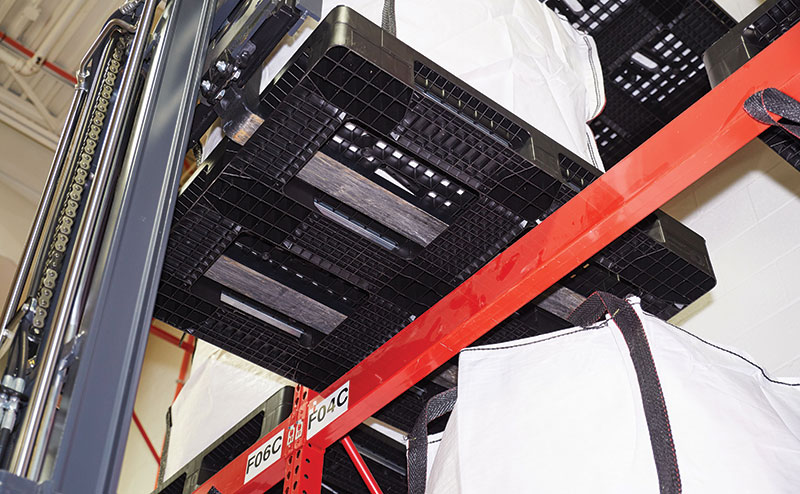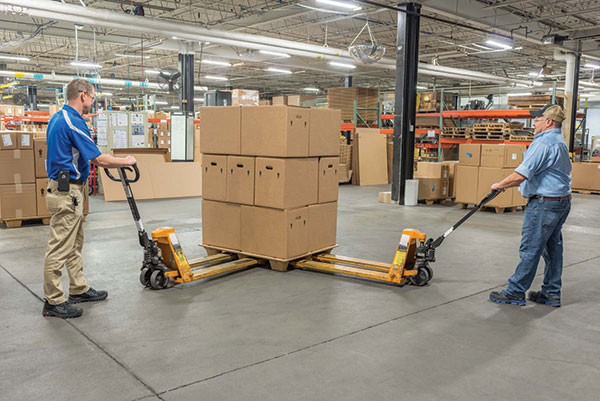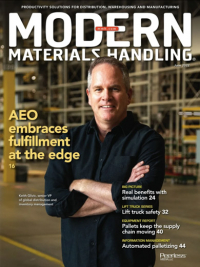Pallets keep the supply chain moving
Demand for pallets is up by about 25% this year. Here’s how manufacturers and users are addressing the demand, meeting those needs and finding alternatives to traditional options.
Used to stack, store, protect and transport a wide range of materials, pallets give companies the firepower they need to handle their goods, improve storage efficiency and safeguard products in the warehouse or DC setting. Up until 2020, these warehouse workhorses were fairly plentiful and generally available as needed.
When the pandemic emerged, the subsequent supply chain issues impacted pallet availability. In particular, a quick rebound in freight volume made wood pallets of certain sizes difficult to find just as a busy housing market boosted lumber prices. “Soaring lumber costs on top of surging e-commerce and the global movement of consumer goods turned the once-mundane shipping tool into a hot commodity,” Bloomberg reported in mid-2021.
The situation hasn’t eased in 2022, but it’s getting more recognition and attention in this third year of the global pandemic. “Pallets are moving the world,” says Ralph Rupert, manager of unit load technology at Millwood. “The events of the last two years have really opened people’s eyes to the importance of the pallet industry and the role it plays in the supply chain.”
Rupert says that while Millwood can still meet its customers’ demands, the company and most others in the pallet sector are “pretty much at capacity right now.” He says the two major pallet markets include 48-inch x 40-inch retail pallets (including recycled ones), which make up about 40% of the total market size, and new, custom-sized pallets. Across both, Rupert says demand is up about 25% over normal.
This demand has been creating havoc for months, although the situation may be easing somewhat. “We see supply havoc on the downstream side in terms of shipping to retail right now,” Rupert adds. “It’s getting slightly better; just a few months ago it was really hand-to-mouth. And going back almost a full year or so, the retail pallet was almost unavailable at that point.”
Some of that unavailability can be traced back to the actual lumber production and transportation, neither of which has been moving at a “normal” pace since the start of the pandemic. And while fluctuating lumber prices do impact pallet costs, Rupert says the freight on board (FOB) mill price—or, the cost of getting the raw materials to the pallet maker—is responsible for pallet cost inflation.

The time it takes for raw materials to get to manufacturers like Millwood is also extended and presents another roadblock to fast pallet production and distribution into the supply chain. “We just got a load of material today from Canada that we ordered in March,” says Rupert, “and that took six weeks to get here.”
Demand outpaces production
With pallet demand outpacing production, lead times increasing and most pallet users experiencing spikes in demand for their products, the supply-demand balance is out of whack and not expected to right itself soon. As these realities come into focus for more companies, demand for pallets is only growing.
“It’s human nature to realize the true value of everything only at the point when we cannot have it,” Gary Sharon, executive vice president at Litco International, points out. “Because of the pallet shortage, users are gaining an appreciation for the value, importance, role and need for pallets to ship finished goods to their customers.”
Right now, Sharon says most users are happy to just get pallets to ship on and will pay “whatever they have to for them.” Some pallet users are buying lumber and making their own pallets in-house, he adds. The approach can be costly, but it does give companies more control over whether they have pallets when they need them.
“At Litco, we’re encouraging our prospects to consider alternatives to the popular sizes, including the 48-inch x 40-inch, knowing that those substitutes may be more readily available and at a lower price,” says Sharon. Engineered molded wood composite pallets, that Litco offers, are another option because they cost less than comparable, new solid-wood pallets, he adds. “They are also certified sustainable and are as strong (and stiffer than) new, solid wood pallets,” he says.
He reminds users that pallet producers tend to be small businesses that don’t have control over the market dynamics. Because of rapidly changing costs and freight issues, he adds, passing pricing changes to customers has become a common strategy that is necessary to operate day-to-day in the current economy. Looking ahead, Sharon expects higher-than-usual pallet prices and tight supplies to be the norm through the rest of 2022.
“A shortage of willing workers will make it difficult for pallet makers to increase production days and pallet output capacity,” he says, noting that even when wood prices begin to recede, pallet prices are likely to stay higher than in the past. “This is because of increased labor, other overhead costs and the shortages of related parts and materials necessary to keep a manufacturing plant running.”
Supporting warehouse automation
As more companies adopt automation in their warehouses and DCs, pallet requirements are also changing. In some cases, those organizations are looking beyond wood and experimenting with composites, plastics and other materials. For instance, Michael Del Vecchio, product manager at ORBIS Corp., says dimensional consistency has become a top-of-mind issue for companies using automation, lasers, cameras and conveyors to produce the same product over and over again.
“When you look at a standard whitewood pallet, the consistency varies more than it would with a plastic pallet,” says Del Vecchio. “If a pallet with a laser eye or camera is off by the slightest bit, it could cause unnecessary downtime for conveyors.”
The nails and shards of wood common with wooden pallets can also create discrepancies. “Wooden pieces break off and nails can damage packaging,” he adds. “The plastic pallet’s dimensional consistency and ability to replicate over and over again helps companies use automation to streamline their processes and save on labor costs.”
As supply chain sustainability continues to come to the forefront, more companies are seeking reusable and recyclable pallet materials. And while wood is a naturally sustainable material, the newer plastics and composites introduce new levels of sustainability in an era where companies and consumers want to minimize their carbon footprints.
Laszlo Horvath, director of the Center for Packaging and Unit Load Design at Virginia Tech, says he’s hearing from more companies that want to use plastic pallets as sustainable alternatives to wood pallets, despite the fact that the latter is available in multi-use iterations. Of particular interest are high-quality, returnable plastic pallets to replace single-use wood pallets.
“Automation may have something to do with the trend because everybody is increasing their automation levels right now,” says Horvath. “Most of the plastic pallets in automated systems are either pool or plastic pallets.” Having put numerous plastic pallets through Virginia Tech’s rapid durability simulator over the last couple of years, Horvath says he’s seen improvement in the products’ durability.
“Five or six years ago, plastic pallet durability was three times lower,” he explains. “Now, we have multiple pallets that we just stopped testing after so many tests; there was no reason to test beyond that. We never had that happen before.”
Horvath is also seeing more composite options hitting the market, where a handful of companies are using plywood core pallets that are sprayed with polyuria resin to create wood core plastic pallets. “These companies just keep popping up, and are being encouraged by the company that’s selling the resin,” he says. “These companies are all producing pallets with fairly similar technology, and are going to hit the marketplace pretty soon.”
A look ahead
This summer, Virginia Tech is planning to conduct a pallet survey that will reveal market production numbers and show whether the number of wood pallets produced increased during the pandemic. Horvath says the survey will span three years (2019 to 2021) and will be focused on the key pallet production trends.
“We know everyone is booming right now; most companies are having their best year ever,” Horvath added, “so we suspect that pallet production is up as well.”
Looking ahead, Horvath expects to see a greater focus on plastics recycling as new, related laws begin to emerge. “Plastics recycling laws are beginning to pop up, and they’re really going to change how we operate,” says Horvath, who adds that there are still many custom, one-way, non-recyclable and/or less recycled pallets being used in supply chains worldwide.
“The new laws may change the wood-to-plastic ratio and increase the focus on multiple-use plastics,” Horvath concludes. “No one knows how that’s going to turn out yet, but if you look at the new regulations that are emerging in Canada and Europe—and assume that they will also begin coming to the United States—that will make a big difference for the pallet industry.”

Article Topics
Pallets News & Resources
Warehouse automation extends life of cheese DC by a decade Two voices of reason on pallet materials PLA Solutions Video - Stay on Top of It All Moving pallets at Aurobindo Pallets and Packaging: It’s time to optimize packaging Insider Q&A: Opening New Doors for Pallet Buyers and Sellers The Pallet Report 2023: Shape shift underway More PalletsLatest in Materials Handling
IFR: robot installations by manufacturing companies up 12 percent last year Geek+ and System Teknik deploy PopPick solution for pharmacy group Med24.dk Beckhoff USA opens new office in Austin, Texas Manhattan Associates selects TeamViewer as partner for warehouse vision picking ASME Foundation wins grant for technical workforce development The (Not So) Secret Weapons: How Key Cabinets and Asset Management Lockers Are Changing Supply Chain Operations MODEX C-Suite Interview with Harold Vanasse: The perfect blend of automation and sustainability More Materials HandlingAbout the Author
Subscribe to Materials Handling Magazine

Find out what the world's most innovative companies are doing to improve productivity in their plants and distribution centers.
Start your FREE subscription today.
April 2024 Modern Materials Handling

Latest Resources












